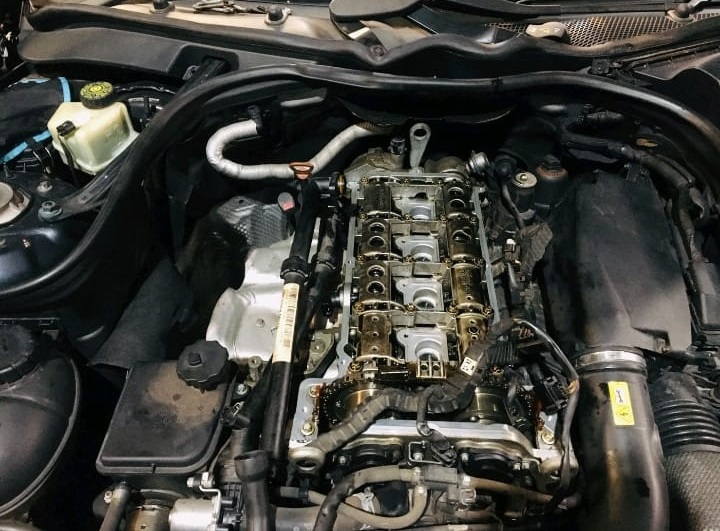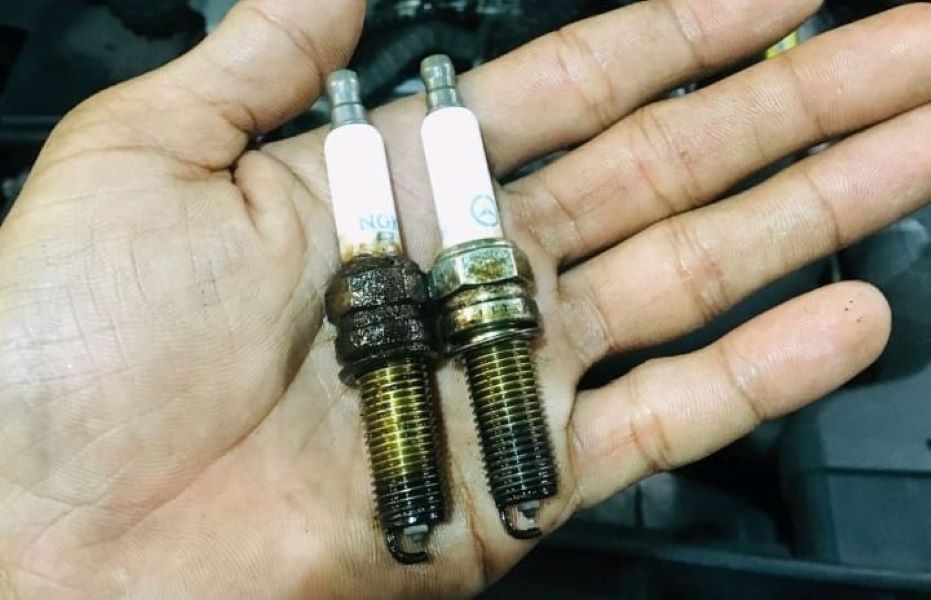Table of Contents
Case Study: Engine Misfiring on Mercedes E Class With M271
When a Mercedes-Benz E Class W212 equipped with the M271 Engine came into the workshop, the primary issue was an Engine Misfiring problem. The customer had noticed rough idling and reduced engine performance, which are classic signs of Engine Misfiring.

Diagnostic Process:
The first step in addressing the Engine Misfiring was to connect the Xentry diagnostic tool to the vehicle. This tool is essential for reading fault codes stored in the engine control unit (ECU), which can provide valuable insights into the cause of the Engine Misfiring.
Upon running the diagnostics, the following fault codes were found:
- P0301: Cylinder 1 Misfire Detected
- P0302: Cylinder 2 Misfire Detected
- P0303: Cylinder 3 Misfire Detected
- P0304: Cylinder 4 Misfire Detected
These fault codes clearly indicated that all four cylinders were experiencing misfires, confirming the customer’s complaint of Engine Misfiring.
Inspection and Findings:
To identify the root cause of the Engine Misfiring, the next step was to inspect the ignition system. The ignition coils were checked first, as they are directly responsible for delivering the spark that ignites the air-fuel mixture in each cylinder. During the inspection, traces of oil were found on the ignition coils, which is abnormal and can lead to Engine Misfiring.

Following this, the spark plugs were removed for further examination. Similar to the ignition coils, the spark plugs also showed signs of oil contamination. This oil presence on the spark plugs can disrupt the ignition process, leading to Engine Misfiring.


Source of Oil Leak:
The discovery of oil on both the ignition coils and spark plugs pointed to an internal oil leak. A thorough inspection revealed that the oil was leaking from the tappet cover, which houses the camshafts and other vital engine components. The tappet cover gasket, which is responsible for sealing the cover to the engine, had degraded over time, allowing oil to seep into the spark plug wells.
Solution and Repair:
To resolve the Engine Misfiring issue, it was decided to replace the tappet cover gasket. This would prevent further oil leakage and protect the ignition system from contamination. Additionally, the spark plugs, which had been compromised by the oil, were also replaced with new ones.

After completing the repairs, the vehicle was reassembled, and the engine was started to verify the results. The engine ran smoothly, with no signs of Engine Misfiring. A final diagnostic scan confirmed that the previous fault codes had been cleared, and the vehicle was restored to optimal performance.
Conclusion:
This case study highlights the importance of a thorough diagnostic process in resolving Engine Misfiring issues. In the Mercedes-Benz E Class W212 with the M271 engine, oil leakage from the tappet cover gasket was the underlying cause of the Engine Misfiring.
By replacing the faulty gasket and spark plugs, the problem was effectively resolved, ensuring a smooth and reliable engine operation for the customer.
Engine Misfire Symptoms
Engine misfires can manifest in various ways, and understanding these symptoms is crucial for diagnosing and addressing the underlying issue. Here are some common symptoms of engine misfires:
1. Rough Idling
- Description: The engine may run unevenly when the vehicle is at idle, causing the car to shake or vibrate.
- Cause: A misfire in one or more cylinders disrupts the smooth operation of the engine.
2. Loss of Power
- Description: The vehicle may struggle to accelerate or maintain speed, especially under load, such as during uphill driving.
- Cause: Misfiring reduces the engine’s power output, making it feel sluggish.
3. Poor Fuel Economy
- Description: Increased fuel consumption and decreased fuel efficiency.
- Cause: When the engine misfires, unburned fuel may be expelled through the exhaust, leading to wasted fuel.
4. Engine Hesitation or Stumbling
- Description: The vehicle may hesitate or stumble when you try to accelerate.
- Cause: A misfire disrupts the engine’s power delivery, causing a lag or hesitation.
5. Check Engine Light (CEL)
- Description: The check engine light may illuminate on the dashboard.
- Cause: The vehicle’s onboard diagnostics system detects the misfire and triggers the warning light, often accompanied by a fault code.
6. Engine Vibrations
- Description: Noticeable vibrations in the engine or throughout the vehicle, especially at certain speeds.
- Cause: A misfiring cylinder causes an imbalance, leading to vibrations.
7. Unusual Exhaust Smell
- Description: A strong smell of gasoline or unusual odors from the exhaust.
- Cause: Unburned fuel due to a misfire can result in a noticeable smell from the exhaust.
8. Backfiring
- Description: A popping sound from the exhaust or intake, often accompanied by flames or smoke.
- Cause: Unburned fuel ignites in the exhaust system, causing a backfire.
9. Difficulty Starting the Engine
- Description: The engine may struggle to start or crank for an extended period before starting.
- Cause: Misfiring can make it harder for the engine to achieve the correct ignition and combustion needed to start.
10. Engine Sputtering
- Description: The engine may sputter or jerk while driving.
- Cause: Inconsistent power delivery due to misfiring cylinders.
Recognizing these symptoms early can help prevent more severe engine damage and ensure timely repairs. If you experience any of these signs, it’s important to diagnose and address the misfire promptly to avoid further complications.
Reasons for engine misfire
Engine misfires can occur due to a variety of reasons, affecting one or more cylinders. Identifying the cause of a misfire is essential for proper diagnosis and repair. Here are some common reasons for engine misfire:
1. Faulty Spark Plugs
- Description: Spark plugs are responsible for igniting the air-fuel mixture in the engine’s cylinders.
- Cause of Misfire: Worn, fouled, or damaged spark plugs may not produce a strong enough spark, leading to incomplete combustion or no combustion at all.
2. Ignition Coil Issues
- Description: Ignition coils convert the battery’s voltage into a high voltage needed to create a spark at the spark plugs.
- Cause of Misfire: A failing ignition coil may not deliver adequate voltage, resulting in weak or inconsistent sparks and causing misfires.
3. Fuel Delivery Problems
- Description: The fuel system, including the fuel injectors, ensures the proper amount of fuel reaches the engine.
- Cause of Misfire: Clogged or malfunctioning fuel injectors can disrupt fuel delivery, leading to a lean or rich air-fuel mixture that causes misfires.
4. Air-Fuel Mixture Imbalance
- Description: The engine requires a precise balance of air and fuel for proper combustion.
- Cause of Misfire: Issues such as vacuum leaks, a faulty mass airflow sensor (MAF), or a malfunctioning oxygen sensor can lead to an improper air-fuel ratio, causing misfires.
5. Compression Issues
- Description: Compression in the engine’s cylinders is necessary for the air-fuel mixture to ignite properly.
- Cause of Misfire: Low compression due to worn piston rings, a blown head gasket, or valve problems can prevent proper combustion, leading to misfires.
6. Faulty EGR Valve
- Description: The Exhaust Gas Recirculation (EGR) valve recirculates a portion of the exhaust gases back into the engine to reduce emissions.
- Cause of Misfire: A stuck or malfunctioning EGR valve can allow too much exhaust gas into the engine, diluting the air-fuel mixture and causing a misfire.
7. Timing Issues
- Description: The engine’s timing refers to the synchronization of the crankshaft and camshaft, which controls the opening and closing of valves.
- Cause of Misfire: If the timing belt or chain is stretched or skips a tooth, the engine’s timing can be off, leading to misfires.
8. Sensor Failures
- Description: The engine relies on various sensors, such as the crankshaft position sensor and camshaft position sensor, to monitor and adjust engine performance.
- Cause of Misfire: A faulty sensor can send incorrect data to the engine control unit (ECU), disrupting the ignition and fuel timing and causing misfires.
9. Exhaust Gas Recirculation (EGR) System Problems
- Description: The EGR system helps reduce nitrogen oxide emissions by recirculating a portion of exhaust gases back into the intake manifold.
- Cause of Misfire: A malfunctioning EGR system can cause uneven combustion and result in misfires.
10. Mechanical Issues
- Description: Mechanical components of the engine must be in good condition for optimal performance.
- Cause of Misfire: Worn or damaged components such as valves, camshaft, lifters, or cylinder walls can lead to misfires due to improper combustion.
11. Faulty Engine Control Unit (ECU)
- Description: The ECU is the computer that manages the engine’s operations.
- Cause of Misfire: A malfunctioning ECU can send incorrect commands to the ignition and fuel systems, leading to misfires.
12. Contaminated Fuel
- Description: The quality of fuel used in the engine plays a significant role in its performance.
- Cause of Misfire: Contaminated or poor-quality fuel can cause incomplete combustion, leading to misfires.
13. Oil Contamination
- Description: Oil leaks in the engine can contaminate ignition components.
- Cause of Misfire: Oil on the spark plugs or ignition coils can disrupt the ignition process, causing misfires.
14. Clogged Catalytic Converter
- Description: The catalytic converter reduces harmful emissions from the exhaust.
- Cause of Misfire: A clogged catalytic converter can create backpressure, affecting the engine’s ability to expel exhaust gases and causing misfires.
Understanding these potential causes can help in accurately diagnosing and resolving engine misfires, ensuring the smooth and efficient operation of the vehicle.






Leave a Reply